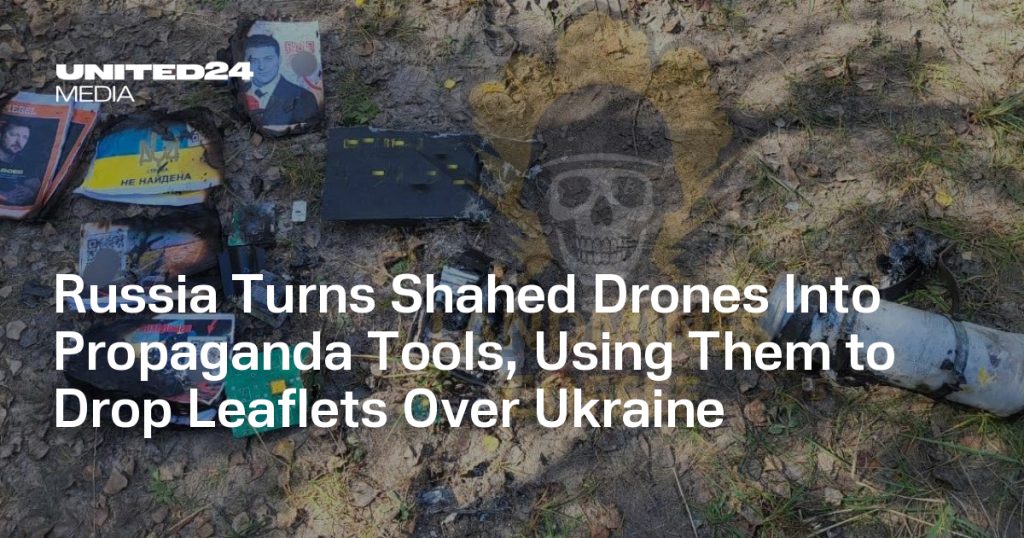Listen to the article
Russia Repurposes Attack Drones for Propaganda Distribution Over Ukraine
Russian forces have begun adapting their drone warfare tactics in Ukraine, modifying Shahed-type suicide drones to serve as propaganda leaflet carriers while maintaining their lethal capabilities. According to a report from the Telegram channel “Landmines and Coffee with Sandwiches” on October 15, this represents a significant evolution in Russia’s psychological warfare operations.
Military analysts examining a recently downed Russian drone discovered a modified cluster container typically used for deploying PTM-3 anti-tank mines. In this case, however, the compartments were filled with propaganda leaflets targeted at Ukrainian civilians or military personnel. The ejection charge remained intact, confirming that the dispersal mechanism was fully functional and would have operated as designed had the drone reached its target area.
“The idea seems fairly simple: just like with PTM-3 mines, at a pre-programmed moment while flying over a designated area, an electric impulse is sent to the blasting cap, which activates the ejection charge to disperse the leaflets,” explained the Telegram channel in its post detailing the discovery.
What makes this adaptation particularly concerning for Ukrainian defenders is that the drones maintain their primary offensive capability. The main warhead remained in place, carrying more than 30 kilograms of explosives. This dual-purpose modification allows Russian forces to conduct psychological operations without sacrificing the drone’s strike potential, essentially getting two strategic benefits from a single platform.
The containers were mounted externally under the drone’s wings, replacing the usual anti-tank payload but keeping the primary explosive intact. Ukrainian forces managed to shoot down this particular drone before it could deploy its propaganda payload.
This innovation comes as both sides in the conflict continue to adapt and evolve their drone warfare techniques. The use of unmanned aerial vehicles has become increasingly sophisticated throughout the Russia-Ukraine war, with both militaries finding new applications for various drone platforms.
The Iranian-made Shahed drones, which Russia has been using extensively against Ukrainian targets, are relatively inexpensive compared to conventional missiles but can cause significant damage to infrastructure and civilian targets. Their low flight altitude and relatively small radar signature make them difficult to detect and intercept, particularly when launched in large numbers.
The psychological warfare component adds another dimension to Russia’s drone strategy. Propaganda leaflets have been used in conflicts for centuries, but delivering them via attack drones represents a modern evolution of this tactic. It allows for targeted messaging to specific areas without risking manned aircraft or ground forces.
Meanwhile, Russia is also enhancing its defensive capabilities against Ukraine’s own drone operations. Recent reports indicate that Russia has been testing a new automated air defense system at the Kapustin Yar test range in the Astrakhan region. This system is retrofitted from the twin-barreled ZU-23-2 anti-aircraft gun and is designed to boost local protection against Ukraine’s increasingly effective long-range drone strikes.
The demonstration of this defensive system was attended by high-ranking Russian officials, including Security Council Deputy Chairman Dmitry Medvedev, suggesting the importance Russia places on countering Ukraine’s drone capabilities.
As the conflict continues into its third year, both sides are likely to further innovate in their use of unmanned systems. The adaptation of attack drones for propaganda purposes demonstrates how conventional weapons platforms are being reimagined to serve multiple strategic objectives simultaneously.
Ukrainian forces will need to adjust their air defense protocols to account for these dual-purpose drones, potentially prioritizing their interception before they can reach populated areas where propaganda materials might be dispersed.
Fact Checker
Verify the accuracy of this article using The Disinformation Commission analysis and real-time sources.




9 Comments
This is a concerning development in the Russia-Ukraine conflict. Modifying attack drones to drop propaganda leaflets is an alarming escalation of Russia’s information warfare tactics. I’m curious to see how Ukraine responds and tries to counter these leaflet drops.
This is a fascinating development in the Russia-Ukraine conflict. Using drones to drop propaganda leaflets is a creative, if concerning, tactic. I wonder what kind of messages Russia is trying to spread through this approach and how effective they think it will be.
Repurposing attack drones to distribute propaganda leaflets is a clever, if concerning, move by Russia. I’m curious to learn more about the specific content of these leaflets and what they’re hoping to achieve. It’ll be important to monitor the impact and Ukraine’s response.
This is a worrying development in the Russia-Ukraine conflict. Modifying attack drones to drop propaganda leaflets is a concerning escalation of Russia’s information warfare tactics. I’m curious to learn more about the content and intended impact of these leaflet drops.
Wow, Russia is really getting creative with their drone tactics. Using them to distribute propaganda leaflets is a sneaky way to spread disinformation. I wonder what kind of messages they’re trying to push with this.
Russia is really getting creative with their drone tactics, huh? Using them to distribute propaganda leaflets is a sneaky way to try and sway public opinion. I wonder what kind of messages they’re trying to push and how effective they think this approach will be.
Interesting to see how Russia is evolving its drone tactics in the Ukraine conflict. Adapting them to distribute propaganda leaflets rather than just explosives is a new twist. I’m curious to learn more about the specific messages they’re trying to convey through this approach.
Russia seems to be getting creative in how they’re using drones against Ukraine. Repurposing them to drop propaganda leaflets is a sneaky tactic. I wonder if it’s an attempt to sway public opinion or demoralize Ukrainian troops. Either way, it’s a concerning escalation in their information warfare.
This is a concerning development in Russia’s information warfare against Ukraine. Modifying drones to drop propaganda leaflets shows their willingness to leverage any means possible, even repurposing military equipment. It’ll be important to closely monitor the content and impact of these leaflet drops.